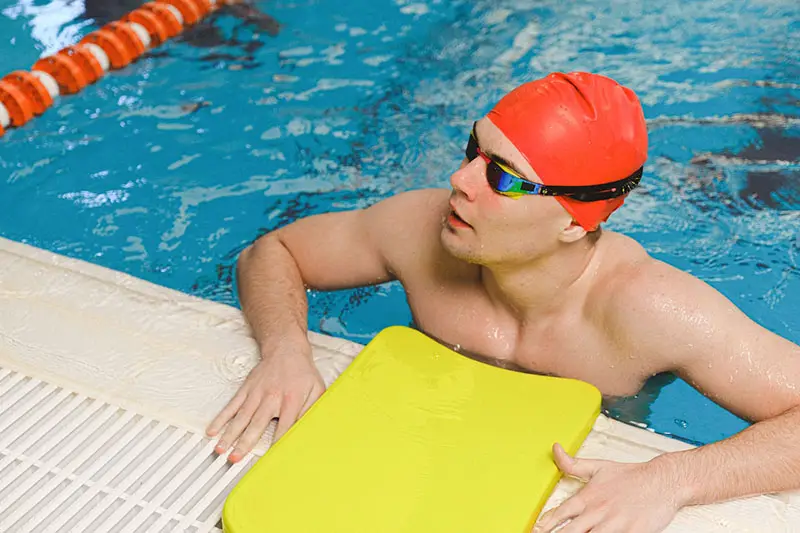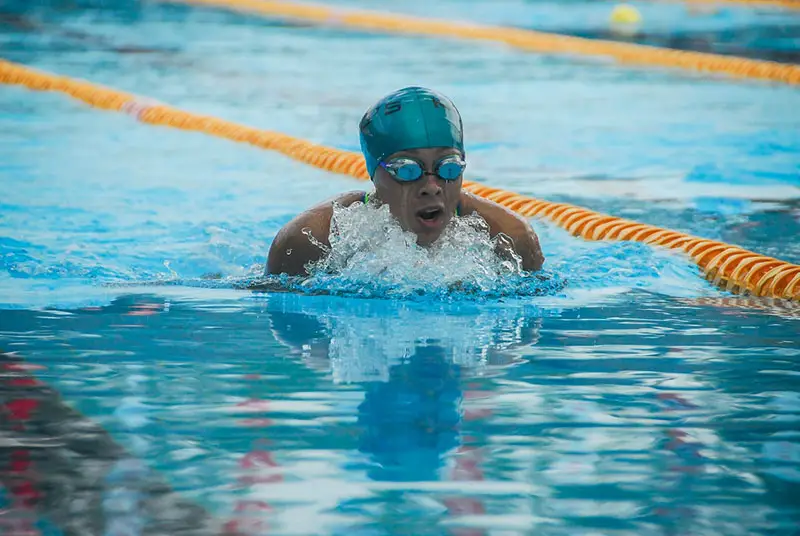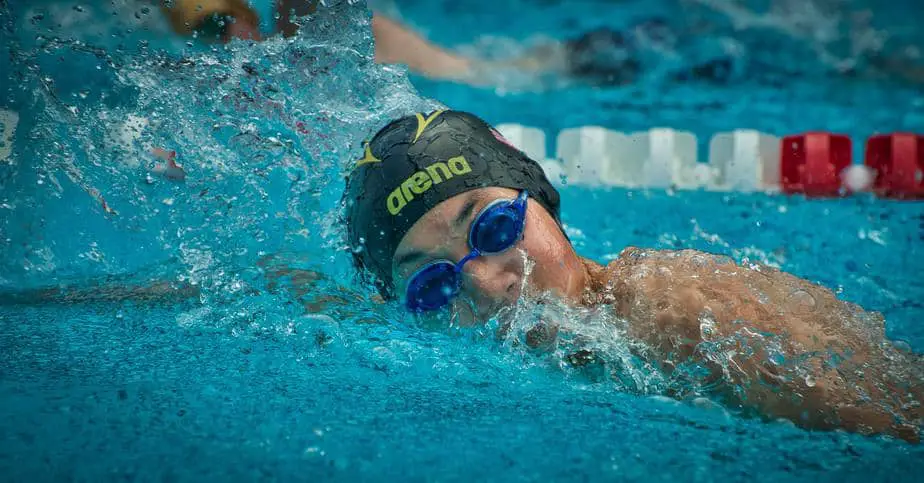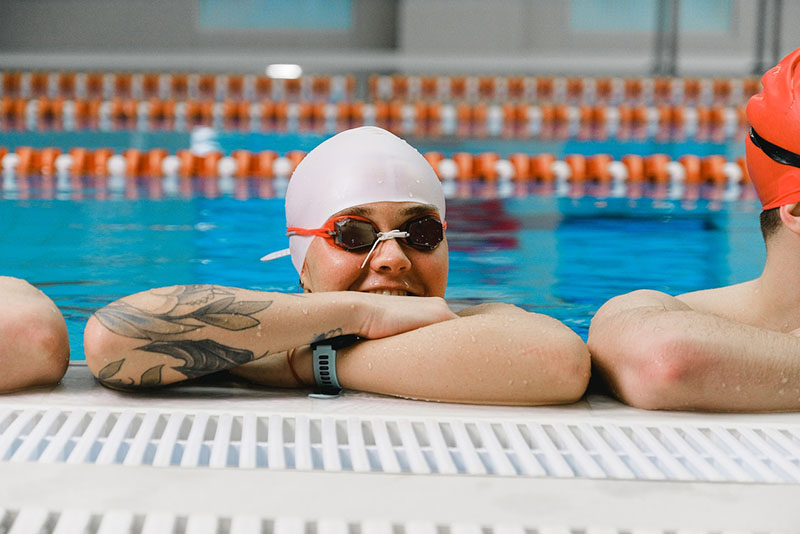Putting on a swim cap seems easy at first, until you try to do it. Then it’s an uncomfortable, hair-pulling, harrowing experience that you don’t want to go through ever again. At least, until you get your technique down pat.
Unfortunately, many swimmers struggle with wearing their swimming cap with goggles. Aside from issues with putting on the cap, there is also the question of: should goggles be worn over or under the cap? Does it even matter?
Putting on a swim cap is a matter of opening the cap wide, wrapping it over your forehead for a solid hold, then pulling the cap back and over the rest of your head and hair. If you’re a recreational swimmer, you probably want to wear the goggles over your head for comfort. If you care about performance, then where you goggles under the swim cap.
Still struggling to put on a swim cap? Unsure about whether you should wear your goggles over or under your swim cap? Read on to get more in-depth explanations.
Should you wear goggles over or under your swim cap?
Wearing them over your swim cap

If you are a recreational swimmer and comfort is your primary concern, then it is a good idea to wear your goggles over your swim cap. There are many practical benefits for doing so.
For starters, if you find yourself frequently adjusting your goggles, then wearing it on the outside gives you easy access to it without needing to take off your swim cap.
It could be that you don’t like the strap positioning, how tight the straps are, or your goggles are fogging up constantly and you need to clear it.
Wearing goggles over a swim cap also feels less restrictive. Rather than the straps digging into your skin, you have a layer of protection separating you from the straps and this feels more comfortable.
Covering your hair with a swim cap also prevents the straps from pulling painfully on your hair. That said, it doesn’t stop the cap from pulling on your hair, but there are ways around that too like wetting your hair or covering it in conditioner.
As you can see, wearing goggles over the swim cap lets you adjust your goggles more easily and this leads to a more comfortable swimming experience.
Wearing them under your swim cap

You might notice most competitive swimmers wear their goggles under their swim caps. After reading about all of the affordances for comfort that wearing goggles over a swim cap offers, why would anyone not want this?
In a word, the answer is: speed. Competitive swimmers only care about how fast they go. They don’t care about how uncomfortable they feel; they just need to endure the discomfort for the few minutes they are actually swimming and then they can take their goggles and cap off.
Wearing their goggles under their swim cap can marginally improve their speed because the strap is covered up by the cap. Swimmers care a lot about their head shape because if it’s not smooth, they are not as hydrodynamic as they possibly can be.
Another benefit for competitive swimmers is that the swim cap can hold the goggle straps firmly in place. If your goggles are ever dislodged, which might happen during the dive, then they have essentially thrown the race.
This also applies to competitive swimmers in open water events such as triathlons, where they might have to contend with strong waves buffeting them. During a competition, you don’t want to worry about if your goggles will stay on your face, so securing your goggles with a swim cap will allow you to focus on what’s really important: swimming fast.
Wearing goggles both over and under the swim cap

Technically, competitive swimmers can wear goggles both over and under their swim caps by wearing two swim caps. This almost sounds like a riddle. Can you solve it?
Essentially, swimmers will wear a latex cap over their head, then wear their swimming goggles over it, then wear a silicone swim cap to cover both their goggles and the first cap.
This might seem like overkill, but that just shows how dedicated to their sport they are. The first swim cap provides a more secure surface for the goggles to wrap around. It also provides some comfort for the swimmer since the straps are not directly pressing against their skin.
The second cap is typically made of a more durable, thicker material called silicone. Silicone caps don’t crinkle as much as latex or lycra caps, so it helps smooth out their head shape when worn over their first cap. This helps secure their goggles in place even more and reduces their drag as well.
If you’re a recreational swimmer you don’t need to go through this hassle, but for competitive swimmers, anything that gives them an edge without breaking any rules is fair game.
How to put on a swim cap in the first place
I kind of glossed over this, but there’s no point even worrying about goggle placement if you can’t even properly wear a darn cap in the first place. It’s difficult at first, but once you’ve developed a technique that works for you, it will be so much easier from then on. I’ll tell you how I put on a swim cap for reference.
First things first, if you have long hair, tie it up in a bun. If you are having issues with your hair getting pulled on by the cap, wet your hair as well. This is something I never need to think about because, like a good pool-goer, I rinse myself before I enter the pool.
Next, I place both hands in the cap, palms facing each other. Then I spread my hands apart, stretching the cap wide open with the back of my hands.
From here, I start to place the cap over my head. To make things easier, I start by first wrapping the cap around my forehead. I then use my forehead to hold the front part of the cap in place as I pull it over the rest of my head towards the back.
Once the cap is stretched over my head, I slowly slide my hands out from underneath the cap and the cap should basically snap into place on my head. Then I adjust as necessary if it feels uncomfortable.
If I wanted to wear my goggles under the swim cap, obviously I’d first wear my goggles before I did anything with the cap.
Confused by my written instructions? If you are more of a visual learner, check out the video below to see how it’s done.
Get the right swim cap
Are you still having trouble putting on a swim cap? Consider if you are wearing the right type of cap. If you have long hair, there are larger swim caps designed specifically to account for your hair bun. It makes you look kind of like an alien but it will be much easier to wear.
It is also very important that the swim cap is the appropriate size to fit snug on your head. If it’s too loose, it is useless because it could slide off your head easily or have a lot of wrinkles which can increase drag. Too small of a size, and it will be uncomfortably tight and you run the risk of tearing it as you try to stretch it over your head.
If the issue is that you have difficulty stretching and pulling on the swim cap, consider the swim cap material. Latex and lycra are two popular types of swim caps that are very stretchy and comfortable. On the other hand, silicone swim caps are more durable and thick but that can make it difficult for a beginner to wear them.
The bottom line
Putting on a swim cap and goggles may be a frustrating experience at first when you are figuring out how tight you want them to fit and how they should sit on your head, i.e. goggles over or under the cap?
However, once you’ve got some experience, you will better understand your preferences and what to look for in a swimming cap and goggles setup. You will also develop a foolproof technique that can allow you to put them on in a jiffy.
To make things easier, start off with a latex cap (or lycra if you’re allergic) because they are stretchy and very comfortable. Then it’s just a matter of practice over a period of time until you’re proficient at wearing swimming caps with goggles.


